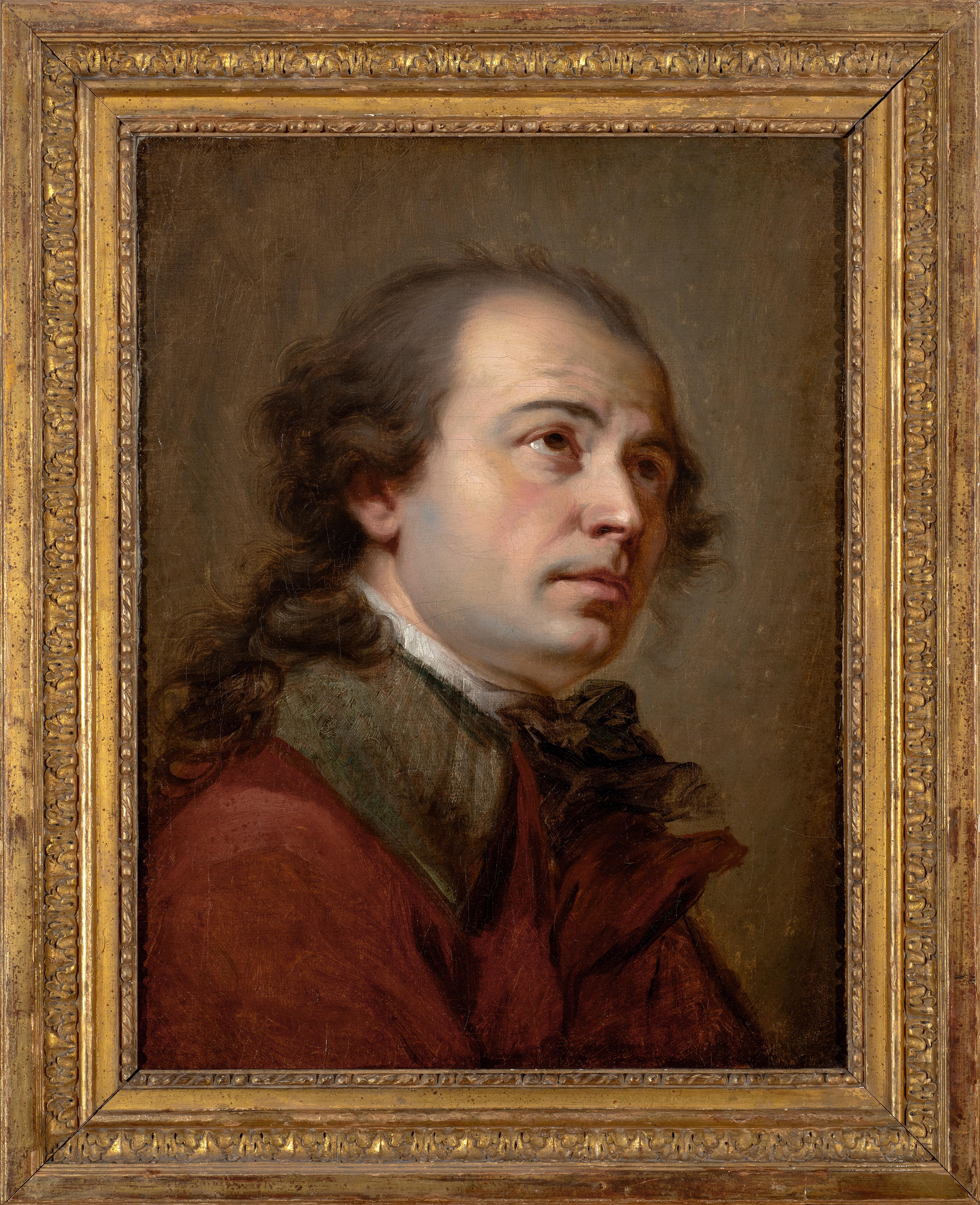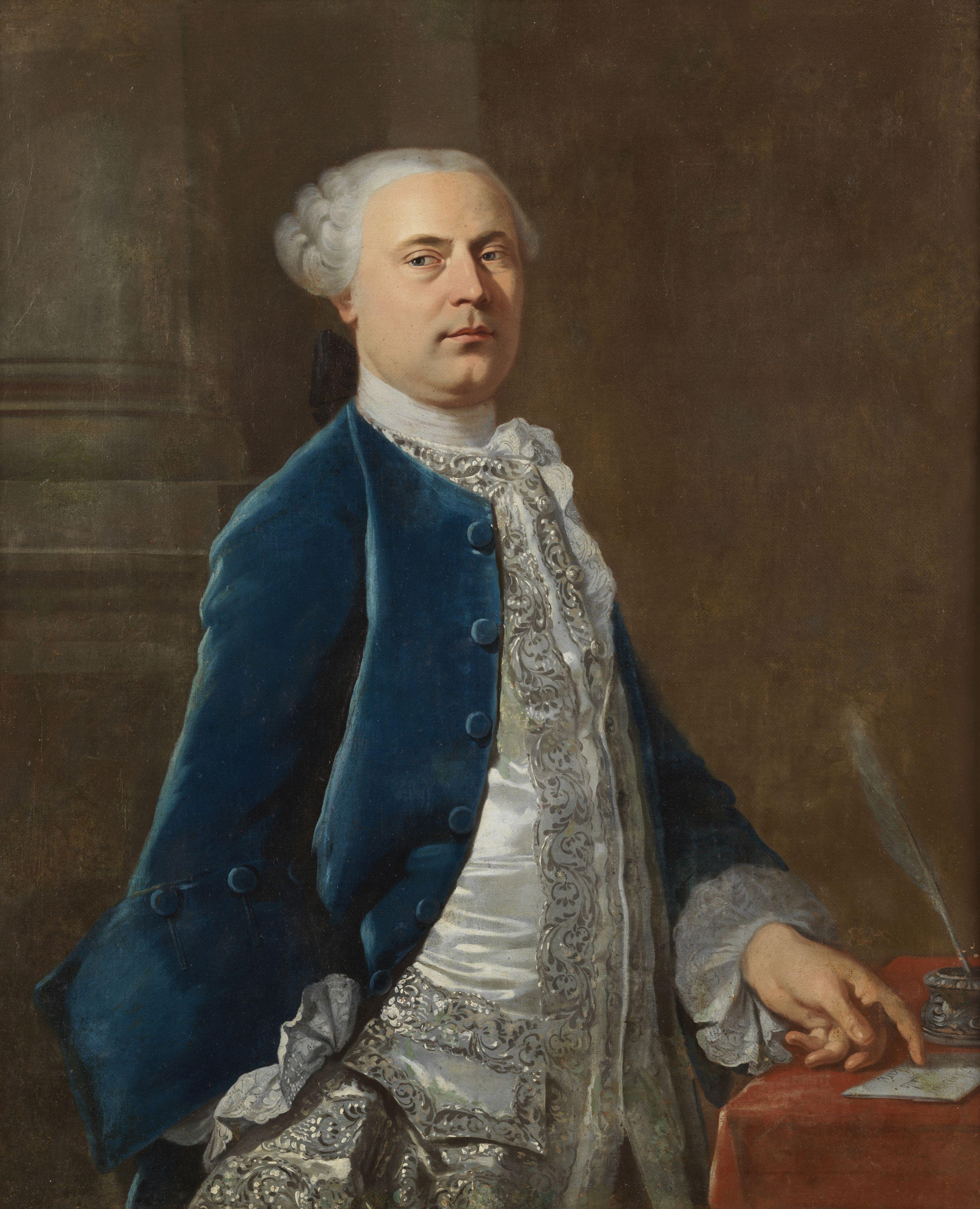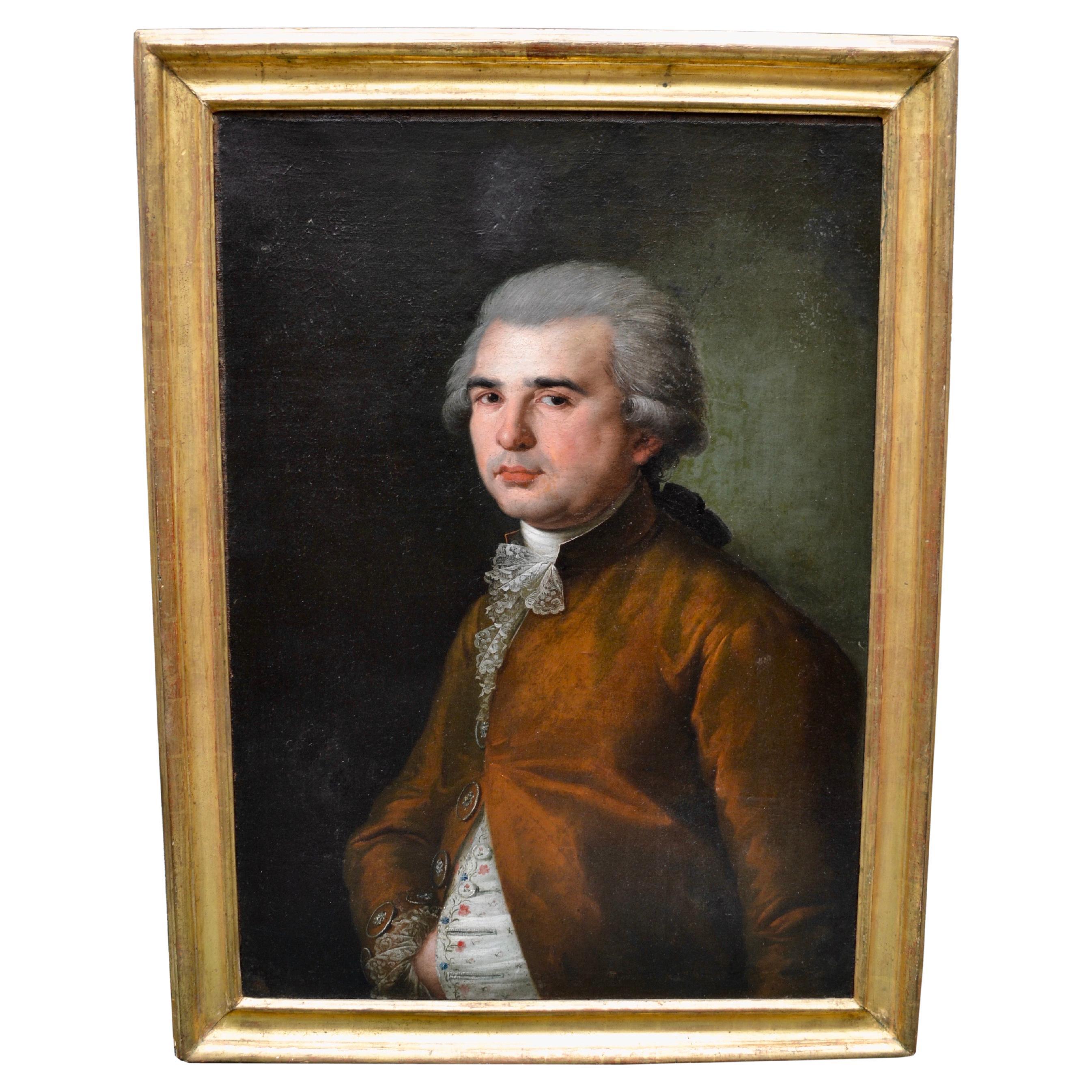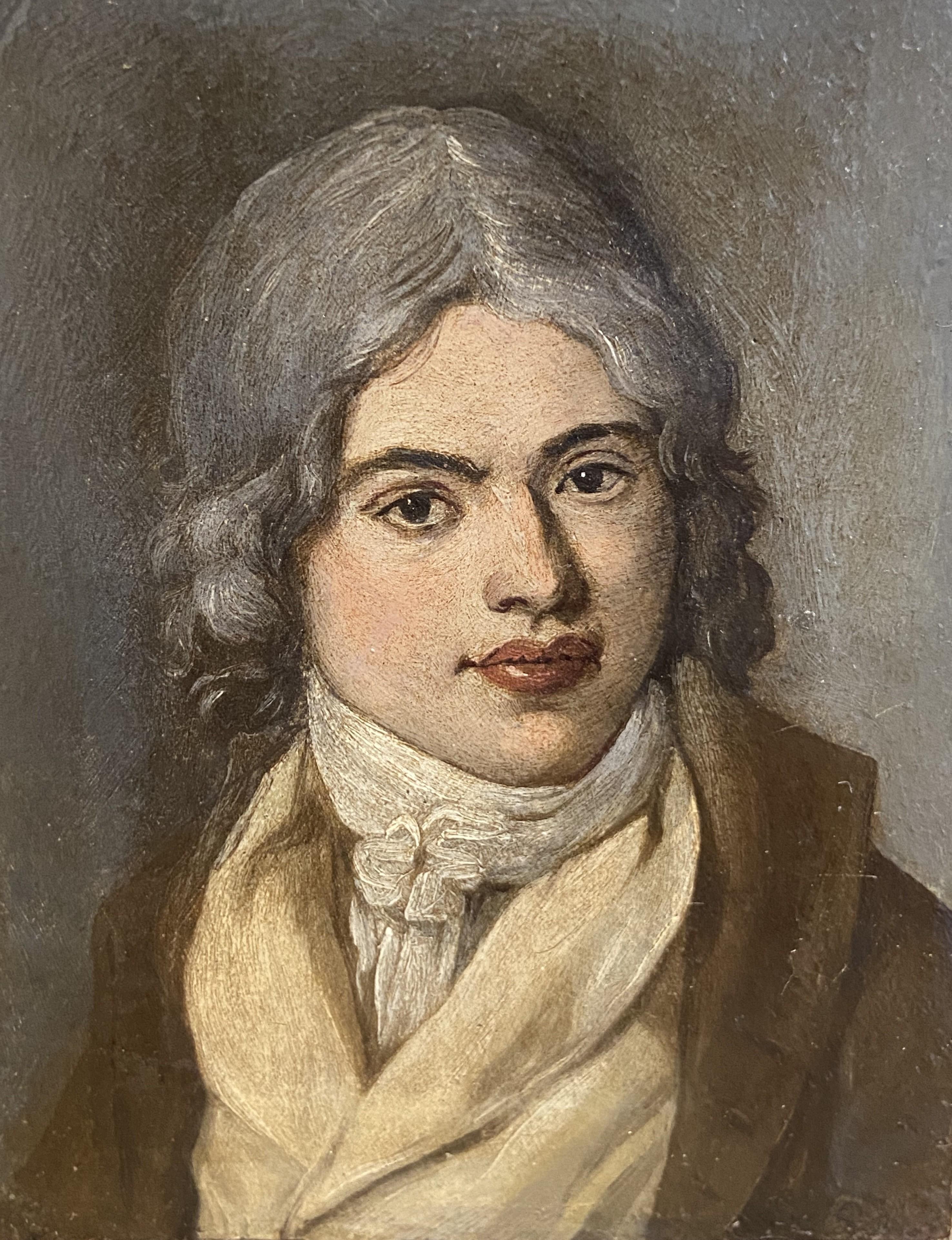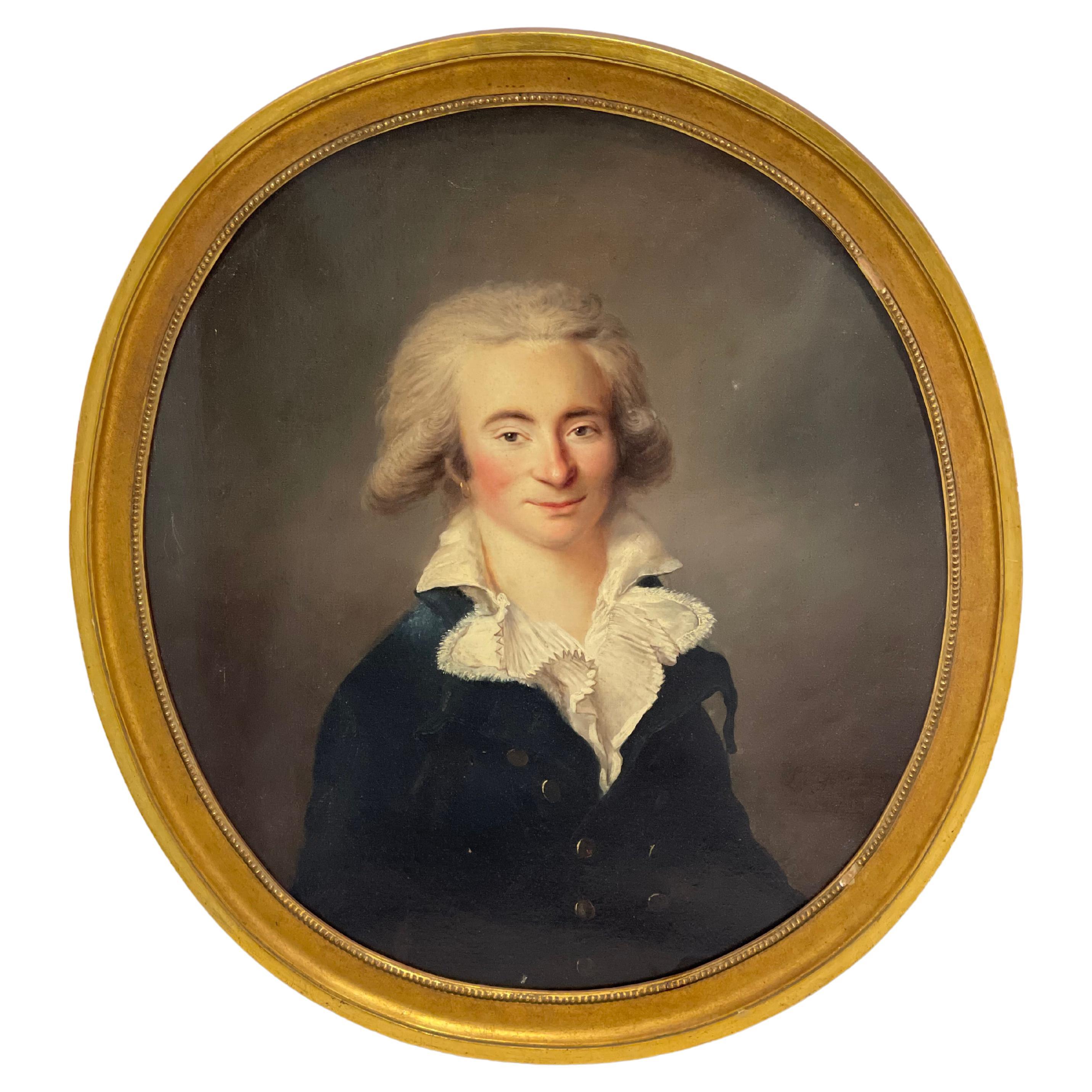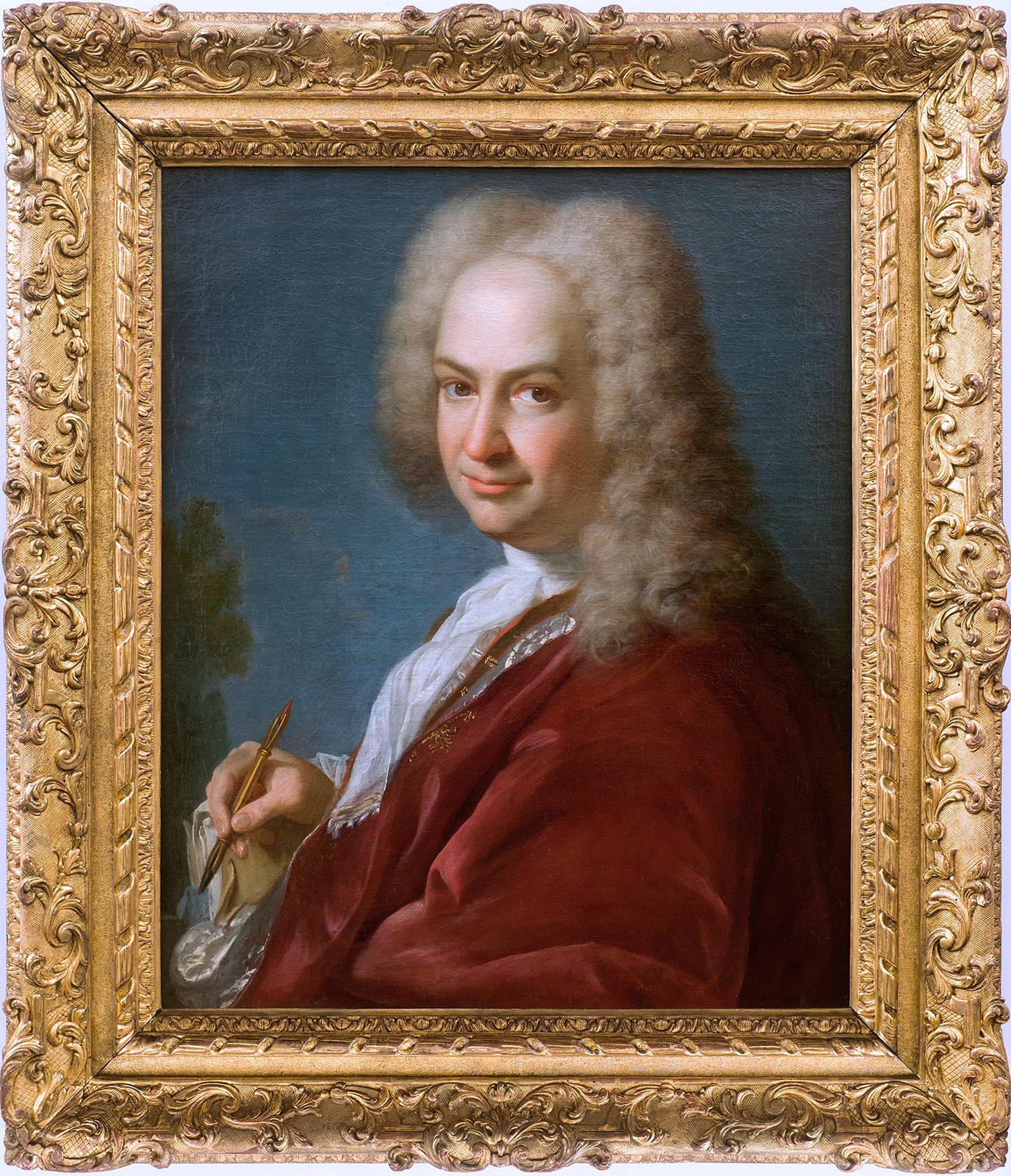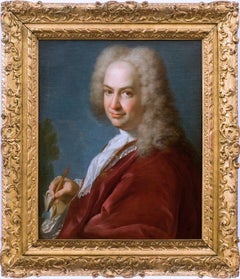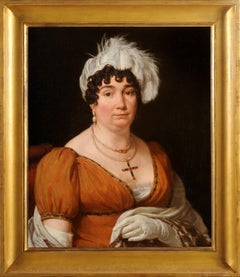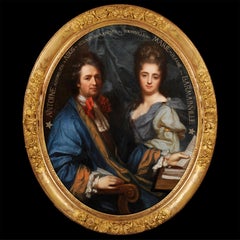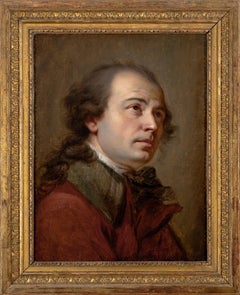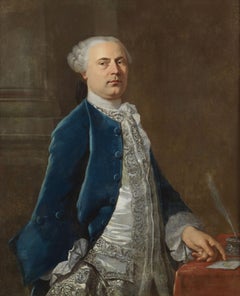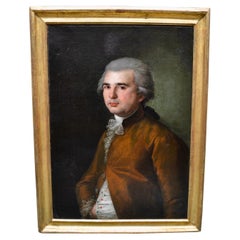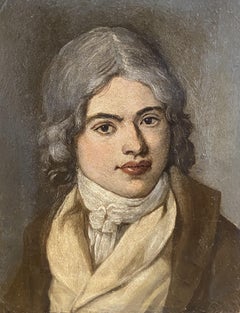Items Similar to Portrait of a man during French Revolution
Want more images or videos?
Request additional images or videos from the seller
1 of 10
Circle of Antoine VestierPortrait of a man during French RevolutionCirca 1793
Circa 1793
$26,170.90
£19,388.03
€22,000
CA$35,996.55
A$40,038.49
CHF 21,004.13
MX$488,560.53
NOK 263,628.42
SEK 248,437.81
DKK 167,505.10
About the Item
Antoine VESTIER, attributed to
(Avallon, 1740 - Paris, 1824)
Portrait of a man under the Revolution
Oil on canvas
H. 46 cm; L. 37 cm
Circa 1793-95
This beautiful unsigned portrait instinctively took us back to the stylistic repertoire of Antoine Vestier, notably with this serene face, this simple pose and a striped garment regularly present in the artist's portraits. However, on closer inspection, the work did not seem to present this silky or satiny side in the touch or this little knowing smile which animates most of the faces painted by the Burgundian artist. While possessing a remarkable quality of execution, it had a drier side. We have reviewed most of the portrait painters from the end of the 18th century, famous or less known, but none really corresponded to ours. It was by closely observing a portrait of a woman by Vestier at the National Museum in Stockholm that we finally came back (both by elimination and by rapprochement) on an attribution to Vestier, with the reservations mentioned previously: the material, the complexions, the mouth, the earlobe, the shine work on the nose, the wig with the rollers highlighted with delicate impasto, the writing of the eyebrows, the treatment of the eyelids are really very comparable. As is very often the case with Vestier, the background is neutral, and the whole gives off an impression of sobriety, enhanced by the colors of the elegant garment. As for the model, one would be tempted to see a revolutionary close to Robespierre, whose physiognomy is not so far removed. His kind gaze, both energetic and gentle, challenges the viewer, not without displaying a slight feeling of satisfaction and superiority. Trained under Jean-Baptiste Pierre, Vestier quickly devoted himself to the genre of portraiture, which he first practiced, and prolifically, in miniature. But he began exhibiting quite late at the Salon du Louvre, in 1785, almost at the same time as his reception at the Academy thanks to the support of Joseph-Siffred Duplessis. He was one of the most distinguished portrait painters of his time.
- Creator:Circle of Antoine Vestier (1740 - 1824)
- Creation Year:Circa 1793
- Dimensions:Height: 18.12 in (46 cm)Width: 14.57 in (37 cm)
- Medium:
- Movement & Style:
- Period:1790-1799
- Condition:
- Gallery Location:BELEYMAS, FR
- Reference Number:1stDibs: LU1857215584242
About the Seller
3.0
Vetted Professional Seller
Every seller passes strict standards for authenticity and reliability
Established in 2017
1stDibs seller since 2022
5 sales on 1stDibs
- ShippingRetrieving quote...Shipping from: BELEYMAS, France
- Return Policy
Authenticity Guarantee
In the unlikely event there’s an issue with an item’s authenticity, contact us within 1 year for a full refund. DetailsMoney-Back Guarantee
If your item is not as described, is damaged in transit, or does not arrive, contact us within 7 days for a full refund. Details24-Hour Cancellation
You have a 24-hour grace period in which to reconsider your purchase, with no questions asked.Vetted Professional Sellers
Our world-class sellers must adhere to strict standards for service and quality, maintaining the integrity of our listings.Price-Match Guarantee
If you find that a seller listed the same item for a lower price elsewhere, we’ll match it.Trusted Global Delivery
Our best-in-class carrier network provides specialized shipping options worldwide, including custom delivery.More From This Seller
View AllPresumed artist self-portrait
Located in BELEYMAS, FR
Louis-Gabriel BLANCHET
(Versailles, 1701 – Rome, 1772)
Presumed self-portrait of the artist
Oil on canvas
H. 73 cm; W. 60 cm
Circa 1730
Originally presented in a Restoration period frame with a "Mignard" cartouche, this beautiful painting initially appeared to us as a work from northern Italy. However, it exuded a rather French form of refinement, suggesting that its artist may have assimilated a dual influence from both sides of the Alps.
We thank our colleague and friend Philippe Mendès for spontaneously and judiciously "bringing out" the name of Louis-Gabriel Blanchet, a Romanized French portraitist, whose spirit and stylistic characteristics we clearly recognize here.
Blanchet's "French" years, before his final departure for Rome in 1728, following his winning of the second Grand Prix for painting after Subleyras in 1727, are extremely poorly documented. His father, Gabriel, was valet to Blouin, himself Louis XIV's first valet at the time. According to Thierry Lefrançois, Blanchet was one of the few students of Nicolas Bertin (1667-1736), whose studio he is said to have joined in the early 1720s. At a baptism on March 24, 1724, where he was godfather, he is mentioned as a painter in the picture store of the Duke of Antin, the director of buildings between 1708 and 1736. At this time, he was probably already married to Jeanne Quément, with whom he had a daughter also named Jeanne, who would marry Nicolas Aviet, the son of a valet in the queen's wardrobe, in Versailles in 1738.
When Blanchet arrived in Rome in October 1728, he was accompanied by Subleyras, Trémolières, and Slodtz. He enjoyed the goodwill of Vleughels, the director of the Académie de France, which had been based at the Palazzo Mancini since 1725, even though the latter was not always kind to our resident. From 1732, he was under the protection of the Duke of Saint-Aignan when he took up his post as ambassador to Rome. Along with Slodtz and Subleyras, they formed a trio of friends, joined by Joseph Vernet shortly after his arrival in Rome in 1734. Slodtz and Blanchet, on the occasion of Subleyras's marriage in 1739, were there to attest that their friend was not bound by any marital commitment, and Blanchet was a witness at Vernet's wedding in 1745.
It is most likely from these early years in Rome that our portrait of the artist dates, the expression and turn of his face irresistibly reminiscent of a self-portrait. The still relatively youthful features may correspond to Blanchet's thirty-something years, and the fluffy wig was still fashionable at this time.
The painting fits well with the depiction of a young painter wanting to display both the beginnings of success and a certain simplicity or restraint. A slight smile expresses a form of assurance in this man with a gentle, sincere gaze and a face radiating a keen sense of wit. We find here the air of intimacy present in almost all of Blanchet's portraits, even those from the 1750s and 1760s, as well as an almost complicity with the viewer. The spirit of the painting is quite close to that of the presumed portrait of Bouchardon (painted around 1730) and the portrait of Pannini, painted in 1736, but it possesses a more natural quality, notably thanks to the absence of decorum. Our work exhibits the characteristics of Blanchet's paintings: elegance, luminosity (especially in the whites), vibrant and refined colors (here, the harmony of the garnet of the garment and the slate blue of the background, whose uniformity is tempered by a very sketched landscape and a grove of greenery), light complexions, rather rosy cheekbones, often full lips, and rather tight framing.
According to the Academy's rules, Blanchet's stay should have ended in the spring of 1732, but, for reasons unknown, he remained in the Eternal City until his death, as did his friend Subleyras, with whom he shared accommodation until the late 1730s. The latter regularly called upon him to collaborate on his paintings, such as The Meal at Simon's. Through Saint-Aignan's intervention, Blanchet was employed in the late 1730s by the Stuart princely family, then exiled in Italy. He notably produced copies (now lost) after Liotard of the portraits of Charles Edward and Henry Benedict, the sons of James III Stuart. The latter also commissioned three other portraits (now in the National Portrait Gallery in London), whose more formal character contrasts with the intimate spirit of Blanchet's portraits. Blanchet frequented English painters, such as the landscape painter Richard Wilson, and studied with the Scottish portraitist Katherine Read...
Category
1730s French School Portrait Paintings
Materials
Oil, Canvas
Portrait of a man in armor
Located in BELEYMAS, FR
Attributed to Jacques DUMONT aka DUMONT LE ROMAIN
(Paris 1701 - 1781)
Presumed portrait of Louis-Joseph de Formanoir (?-1732)
Oil on canvas
H. 91.5 cm; L. 73 cm
Signed on the helmet:...
Category
1750s French School Portrait Paintings
Materials
Canvas, Oil
Portrait of Madame Leblond
Located in BELEYMAS, FR
French school circa 1815
Portrait of Madame Leblond
Oil on canvas
H. 66 cm; W. 55 cm
Named on the back
Comparable to the works of painters such as Louis Hersent, our portrait, unsig...
Category
1810s French School Figurative Paintings
Materials
Canvas, Oil
Portrait of a couple
Located in BELEYMAS, FR
Jean-Baptiste SANTERRE
(Magny en Véxins 1651 - Paris 1717)
Portrait of a couple
Oil on original oval canvas
H. 115 cm; L. 90 cm (140 x 115 cm with frame)
Around 1695
Jean-Baptiste S...
Category
1690s French School Portrait Paintings
Materials
Canvas, Oil
Italian men portrait
By Giovanni Maria delle Piane dit Mulinaretto (Genoa 1670 - Monticelli d´Ongina 1745)
Located in BELEYMAS, FR
Giovanni Maria DELLE PIANE, known as IL MULINARETTO
(Genoa, 1660 – Monticelli d'Ongina, 1745)
Portrait of a man
Oil on oval canvas
H. 108 cm; L. 83 cm
Provenance: Nino Ferrari Colle...
Category
1740s Italian School Portrait Paintings
Materials
Canvas, Oil
Portrait of a young woman in Louis XV period dress
Located in BELEYMAS, FR
French School
Portrait of a young woman in Louis XV period dress
Pastel on paper mounted on oval canvas
H. 68 cm; W. 54 cm (Frame: H. 102 cm; W. 71 cm)
18th century frame, anti-refle...
Category
Mid-18th Century French School Figurative Paintings
Materials
Canvas, Paper, Pastel
You May Also Like
Tête d’expression portrait study of a gentleman
Located in Maidenhead, GB
French Academic School, 18th century
A tête d’expression study of a gentleman, c. 1780-90
Oil on canvas
46.1 x 35 cm.; (within frame) 57.5 x 46.6. cm.
Provenance:
Private Collectio...
Category
1780s French School Portrait Paintings
Materials
Oil
18th Century Portrait of a Gentleman French School Man Oil on Canvas Blue White
Located in Sanremo, IT
Painting, oil on canvas, measuring 92 x 75 cm without frame and 102 x 87 cm with frame depicting a nobleman of the French school of the first half of the 18th century.
In its formal...
Category
Early 18th Century French School Portrait Paintings
Materials
Canvas, Oil
18th Century Portrait of a French Aristocratic Gentleman
Located in Vancouver, British Columbia
A fine half length portrait of a powder wigged 18th century French aristocratic gentleman simply dressed in a brown waistcoat over an embroidered buttoned vest in which he has placed...
Category
Antique Late 18th Century French Louis XVI Paintings
Materials
Canvas
French school late 18th Century, Portrait of a young man, oil on metal
Located in Paris, FR
French school late 18th Century
Portrait of a young man
oil on metal
10.2 x 7.7 cm
Framed under glass : 24.4 x 21.8 cm
This small portrait painting, quite original in its technique...
Category
Late 18th Century Old Masters Portrait Paintings
Materials
Oil
French 18th Century Portrait Signed Legrand, 1790
Located in palm beach, FL
18th century oval portrait oil on canvas of an aristocrat
The individual with the mischievous look wears a highly voluminous powdered starch hairdo.
An earring on his ear is a rare example of coquetry in a picture.
His corner smile and brave cheekbones distinguish the character.
The eighteenth century is an era of grace.
We have never seen men and women so properly prepared throughout history.
The extravagant display was consistent with the rococo aesthetic.
Powdered hairstyles became fashionable among males in the 17th century, under the reign of Louis14, the Sun King.
At the period, France ruled fashion, and its influence expanded to other countries.
This gentleman reflects the entirety of the Grand Siecle...
Category
Antique 1790s French Paintings
Materials
Canvas, Giltwood, Paint
Large 1800's French Oil on Wood Panel Portrait of a Rugged Dressed Man
Located in Cirencester, Gloucestershire
Portrait of a Man
French artist, circa 1800's period
oil on wood panel, unframed
panel: 23 x 18 inches
provenance: private collection, Honfleur, Normandy, France
condition: some sur...
Category
Early 19th Century French School Portrait Paintings
Materials
Oil
$915 Sale Price
30% Off
More Ways To Browse
Texas Revolution Or Alamo Paintings
French Revolution
French Miniature Portraits
Portrait Miniatures France
Antique French Miniature Portrait
Antique Rollers
18th Century Portrait Of Woman
18th Century Portrait Of A Woman
Antique Miniature Portrait Artists
French Wig
Antique Miniature Oil Paintings
1790 Oil Painting
Miniature Display Case
Portrait Of A Man French 18th Century
Miniature Portrait Case
Large Peter Max
Matador Vintage
Peasant Girl
